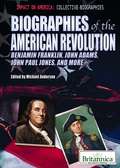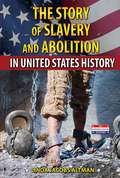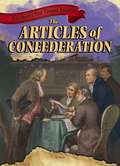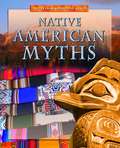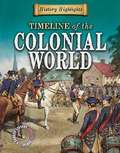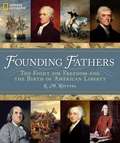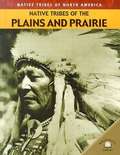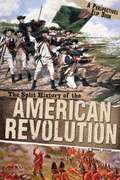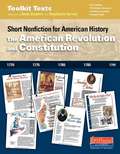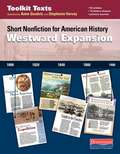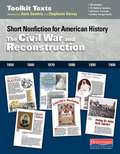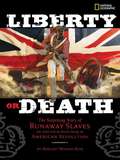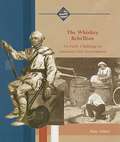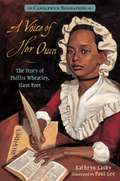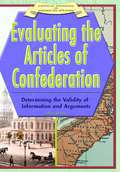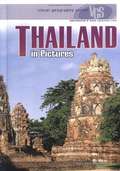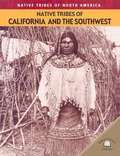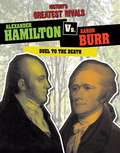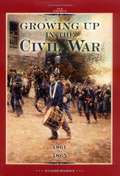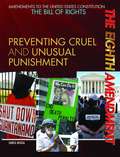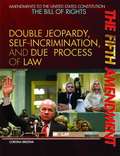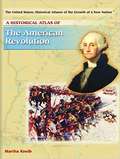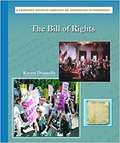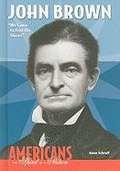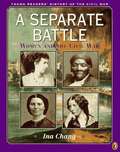Special Collections
District List: NYC Core Curriculum 7th - Social Studies
Description: The New York City Core Curriculum program aims to provide a high-quality curricula to NYC students through a seamless instructional program across grades and subjects. This list has been curated by #NYCDOE for 7th Grade Social Studies materials.
- Table View
- List View
Biographies Of The American Revolution
by Michael AndersonA captivating series that surveys the lives of the political figures and social revolutionaries who shaped early U.S. history includes vibrant images depicting memorable events and individuals, a glossary, explanations of key terms and ideas, and relevant websites and organizations to consult for further reference.
The Story of Slavery and Abolition in United States History
by Linda Jacobs AltmanTraces the history of slavery in the United States, focusing on the abolition movement and the final steps that freed an enslaved people.
The Articles of Confederation
by Blair BeltonMany people don't know that the US Constitution isn't the first American constitution. The Articles of Confederation was the document that united the newly created states in 1781. Not everything went smoothly in the early days of our country. Readers will find out the events that led to the replacement of this constitution. They'll learn its strengths, weaknesses, and why the US Constitution may have been the country's last hope of staying united.
Native American Myths
by Anita DalalOne of the most interesting ways to learn about other cultures is through the myths, legends and stories that they pass on to successive generations, which ultimately explain larger truths about the societies and cultures from which they originate.
A Timeline of the Colonial World
by Charlie SamuelsChronicles the important events, people, and locations during the Colonial era, including the age of exploration, the settling of North America, the American Revolution, and the colonization of Australia and Africa.
Founding Fathers
by K. M. Kostyal and Jack N. RakoveKostyal tells the story of the great American heroes who created the Declaration of Independence, fought the American Revolution, shaped the US Constitution--and changed the world. The era's dramatic events, from the riotous streets in Boston to the unlikely victory at Saratoga, are punctuated with lavishly illustrated biographies of the key founders--Alexander Hamilton, John Adams, Ben Franklin, Thomas Paine, Thomas Jefferson, George Washington, and James Madison--who shaped the very idea of America. An introduction and ten expertly-rendered National Geographic maps round out this ideal gift for history buff and student alike. Filled with beautiful illustrations, maps, and inspired accounts from the men and women who made America, Founding Fathers brings the birth of the new nation to light.
Native Tribes of the Plains and Prairie
by Michael JohnsonThis series provides a comprehensive reference library on the Native nations and peoples of North America, covering essential information on 400 different tribes. Organized according to traditional geographical and cultural groupings, this collection provides an informative view of the diversity of Native North America, from the Canadian Arctic to the Rio Grande. Each volume features historical photographs, regional maps, historic and updated census information, a guide to prominent museums specializing in Native culture, and a comprehensive index to the tribes featured in all six volumes.
The Split History of the American Revolution
by Michael Burgan and Lawrence Babits and Kathleen Baxter and Robert L. McConnellPeople from Great Britain came to North America to start new lives in the 13 American colonies. In the beginning colonists accepted British rule without question. But by the mid-1700s, things were changing. Many colonists wanted the right to govern themselves. The British government felt as if the colonists were being ungrateful. By 1775 war between the two sides was inevitable.
American Revolution And Constitution
by Stephanie Harvey and Anne Goudvis52 short nonfiction texts for American History (1750-1800) with 10 new lessons for content literacy
"We turn information into knowledge by thinking about it. These texts support students in using the Toolkit's comprehension and thinking strategies as tools to acquire and actively use knowledge in history." -Stephanie Harvey and Anne Goudvis
To support cross-curricular strategy instruction and close reading for information, Stephanie Harvey and Anne Goudvis have expanded their Toolkit Texts series to include a library of short nonfiction for American history with 10 all-new Toolkit lessons.
Building on selections from popular children's magazines as well as original articles, these engaging, age-appropriate texts will keep your active literacy classroom awash in historical resources that depict the controversies, issues, and dramas that shaped historical events, including the exploits of lesser-known individuals.
These short nonfiction texts for American history include:
10 comprehension strategy lessons for close reading in content literacy. Short nonfiction articles on a wide range of topics and at a variety of reading levels. ( 45 articles in Colonial Times and 52 articles in The American Revolution and Constitution ) A bank of historical images, primary source documents and artifacts, plus primary source documents and artifacts bibliographies, web sites, and ideas for online investigations. A Digital Companion Resource provides all of the texts, primary source documents, and the image bank in a full-color digital format so you can display them for group analysis. Lesson Title 1 Read and Annotate: Stop, think, and react using a variety of strategies to understand 2 Annotate Images: Expand understanding and learning from visuals 3 Build Background to Understand a Primary Source: Read and paraphrase secondary sources to create a context for a topic 4 Read and Analyze a Primary Source: Focus on what you know and ask questions to clarify and explain 5 Compare Perspectives: Explore the different life experiences of historical figures 6 Read Critically: Consider point of view and bias 7 Organize Historical Thinking: Create a question web 8 Read with a Question in Mind: Focus on central ideas 9 Surface Common Themes: Infer the big ideas across several texts 10 Synthesize Information to Argue a Point: Use claim, evidence, and reasoning The CCSS and other state standards expect that children will read a variety of texts on a common topic and synthesize the ideas and information.
These short nonfiction texts were selected using the following criteria: Interest/Content Because kids love the quirky and the unexpected, these texts highlight important but often lesser-known or unrecognized perspectives and voices from the past. Visual literacy Since visual literacy is an essential 21st-century skill, these texts include historical images, paintings, and maps, as well as diagrams, timelines, charts, and photographs. Writing quality and accuracy To foster student engagement, these articles feature vibrant language in an active voice supported by a rich assortment of visual features. Reading level/complexity These texts are written at a range of reading levels and include a wide variety of topics to capture the interests of all readers.
Short Nonfiction For American History
by Stephanie Harvey and Anne Goudvis"We turn information into knowledge by thinking about it. These texts support students in using the Toolkit's comprehension and thinking strategies as tools to acquire and actively use knowledge in history."-Stephanie Harvey and Anne Goudvis
To support cross-curricular strategy instruction and close reading for information, Stephanie Harvey and Anne Goudvis have expanded their Toolkit Texts series to include a library of short nonfiction for American history with 10 all-new Toolkit lessons.
Building on selections from popular children's magazines as well as original articles, these engaging, age-appropriate texts will keep your active literacy classroom awash in historical resources that depict the controversies, issues, and dramas that shaped historical events, including the exploits of lesser-known individuals.
These short nonfiction texts for American history include:
10 comprehension strategy lessons for close reading in content literacy. Short nonfiction articles on a wide range of topics and at a variety of reading levels. A bank of historical images, primary source documents and artifacts, plus primary source documents and artifacts bibliographies, web sites, and ideas for online investigations. A Digital Companion Resource provides all of the texts, primary source documents, and the image bank in a full-color digital format so you can display them for group analysis.
Short Nonfiction For American History
by Anne Goudvis and Stephanie Harvey"We turn information into knowledge by thinking about it. These texts support students in using the Toolkit's comprehension and thinking strategies as tools to acquire and actively use knowledge in history."-Stephanie Harvey and Anne Goudvis
To support cross-curricular strategy instruction and close reading for information, Stephanie Harvey and Anne Goudvis have expanded their Toolkit Texts series to include a library of short nonfiction for American history with 10 all-new Toolkit lessons.
Building on selections from popular children's magazines as well as original articles, these engaging, age-appropriate texts will keep your active literacy classroom awash in historical resources that depict the controversies, issues, and dramas that shaped historical events, including the exploits of lesser-known individuals.
These short nonfiction texts for American history include:
10 comprehension strategy lessons for close reading in content literacy.
Short nonfiction articles on a wide range of topics and at a variety of reading levels.
A bank of historical images, primary source documents and artifacts, plus primary source documents and artifacts bibliographies, web sites, and ideas for online investigations.
A Digital Companion Resource provides all of the texts, primary source documents, and the image bank in a full-color digital format so you can display them for group analysis.
Lesson Title 1 Read and Annotate: Stop, think, and react using a variety of strategies to understand 2 Annotate Images: Expand understanding and learning from visuals 3 Build Background to Understand a Primary Source: Read and paraphrase secondary sources to create a context for a topic 4 Read and Analyze a Primary Source: Focus on what you know and ask questions to clarify and explain 5 Compare Perspectives: Explore the different life experiences of historical figures 6 Read Critically: Consider point of view and bias 7 Organize Historical Thinking: Create a question web 8 Read with a Question in Mind: Focus on central ideas 9 Surface Common Themes: Infer the big ideas across several texts 10 Synthesize Information to Argue a Point: Use claim, evidence, and reasoning
The CCSS and other state standards expect that children will read a variety of texts on a common topic and synthesize the ideas and information.
These short nonfiction texts were selected using the following criteria: Interest/Content Because kids love the quirky and the unexpected, these texts highlight important but often lesser-known or unrecognized perspectives and voices from the past. Visual literacy Since visual literacy is an essential 21st-century skill, these texts include historical images, paintings, and maps, as well as diagrams, timelines, charts, and photographs. Writing quality and accuracy To foster student engagement, these articles feature vibrant language in an active voice supported by a rich assortment of visual features. Reading level/complexity These texts are written at a range of reading levels and include a wide variety of topics to capture the interests of all readers.
Liberty or Death
by Margaret Whitman BlairLiberty or Death is the little-known story of the American Revolution told from the perspectives of the African-American slaves who fought on the side of the British Royal Army in exchange for a promise of freedom. Motivated by the 1775 proclamation by Virginia’s Royal Governor that any slaves who took up arms on his behalf would be granted their freedom, these men fought bravely for a losing cause. Many of the volunteers succumbed to battle wounds or smallpox, which ran rampant on the British ships on which they were quartered. After the successful Revolution, they emigrated to Canada and, ultimately to West Africa. Liberty or Death is the inspiring story of the forgotten freedom fighters of America’s Revolutionary War.
The Whiskey Rebellion
by Katy SchielWhen Congress enacted a 25 percent excise tax on domestically produced distilled spirits, grain growers and distillers were irate. Especially upset were the small producers of alcohol who began to organize an opposition. When mobs organized an opposition, a tax collector was tarred and feathered and another had his home burned. Shots were exchanged. President Washington called upon the rebels to disperse, but his pleas were ignored. A force of nearly 13,000 men was raised and quelled the opposition, which quickly faded away.
A Voice Of Her Own
by Kathryn Lasky and Paul LeeIn 1761, a young African girl was sold to the Wheatley family in Boston, who named her Phillis after the slave schooner that had carried her. Kidnapped from her home in Africa and shipped to America, she'd had everything taken from her family, her name, and her language. But Phillis Wheatley was no ordinary young girl. She had a passion to learn, and the Wheatleys encouraged her, breaking with unwritten rule in New England to keep slaves illiterate. Amid the tumult of the Revolutionary War, Phillis Wheatley ultimately had a book of verse published, established herself as the first African American woman poet this country had ever known. She also found what had been taken away from her and from slaves everywhere: a voice of her own.
Evaluating the Articles of Confederation
by Greg RozaThis is a fascinating look at the state of the nation at the time of the drafting of the Articles of Confederation seen against the backdrop of revolution, the various ideological debates and practical considerations that shaped it, and the document's inherent weaknesses that necessitated its replacement with the Constitution.
Thailand in Pictures
by Stacy Taus-BolstadDescribes the geography, history, government, economy, people, and cultural life of Thailand.
Native Tribes of California and the Southwest
by Michael Johnson and Bill YenneThis series provides a comprehensive reference library on the Native nations and peoples of North America, covering essential information on 400 different tribes. Organized according to traditional geographical and cultural groupings, this collection provides an informative view of the diversity of Native North America, from the Canadian Arctic to the Rio Grande. Each volume features historical photographs, regional maps, historic and updated census information, a guide to prominent museums specializing in Native culture, and a comprehensive index to the tribes featured in all six volumes.
Alexander Hamilton Vs. Aaron Burr
by Ellis RoxburghAlexander Hamilton and Aaron Burr came from differing backgrounds, but rose to great stature in the years following the American Revolution. As Secretary to the Treasury, Hamilton tackled the fragile finances of the new nation. Burr became the third US vice president in 1800. Readers may wonder how two such prominent men wound up in a duel that ultimately took Hamilton's life and ended Burr's political career. This is the engrossing account of the incidents that led to that fateful morning in 1804. Background information of the era, a timeline, quotes, and historical paintings enhance readers' understanding of the post-revolutionary country.
Growing Up In The Civil War, 1861 To 1865
by Duane DamonLook at life through the eyes of children who lived during different eras of American history... Experience the thrill of landing in the New World for the first time and the terror of dodging bullets during the American Revolution. Journey to the American West in the back of a covered wagon and discover the horrors of the Civil War. From the technological advances of the early twentieth century to the despair of the Great Depression to the sacrifice of World War II, explore each tumultuous time. Our America reveals the true-life adventures of children (many of whom grew up to become presidents or other important national figures), through features such as historical sidebars, quotes from primary resources like diaries and letters, epigraphs, and art authentic to each era. Supports the national curriculum standards Culture; Time, Continuity, and Change; Individual Development and Identity; Individuals, Groups, and Institutions; Power, Authority, and Governance; Global Connections; and Civic Ideas and Practice as outlined by the National Council for the Social Studies.
The Eighth Amendment
by Greg RozaPrior to the existence of the Eighth Amendment, there was little to protect citizens of the English colonies from excessive bail, excessive fines, and cruel and unusual punishments. The enduring freedoms guaranteed by this amendment are extremely important to all U.S. citizens. Readers will learn about the politicians who fought for the amendment's passage. They will also learn about what life was like for Americans before the Eighth Amendment was passed, how the amendment's elastic wording has helped it remain relevant through the years, and how it defends our freedoms today.
The Fifth Amendment
by Corona BrezinaThe Fifth Amendment is the longest amendment in the Bill of Rights, so this book begins by breaking down each clause one-by-one, explaining the legalese in uncomplicated language, thus allowing the reader to reach a full understanding of due process. It then explains the ratification process of the Bill of Rights and systemically describes the impact of the Fifth Amendment clause by clause, using Supreme Court cases as real-world examples. Sidebars highlight the amendment in action and delve into finer points, such as the Fourteenth Amendment s impact on the Fifth and the McCarthy era. This book features a list of all the Amendments to the Constitution, including those proposed, but unratified. A rich resource section allows for further exploration.
A Historical Atlas Of The American Revolution
by Martha KneibA Historical Atlas of the American Revolution profiles the conditions of the American colonies under Great Britain and how colonists were angered enough to fight for their independence. Using primary source images, maps, and clear text, this book covers both the American and British victories in the Revolution, as well as the pivotal events such as the Boston Tea Party and Shay s Rebellion that led up to the fight. This is an objective and fascinating look at our American forefathers, the early patriots who fought for our freedom, and the environment that helped make it happen.
The Bill Of Rights
by Karen J. DonnellyThe Bill of Rights established the fundamental principles the nation was founded on including freedom of speech, freedom of the press, and a speedy public trial by jury. Students will learn the origins of these original ten important amendments to the Constitution and their impact on American law and politics.
John Brown
by Anne E. SchraffThis story will captivate and inspire your readers. John Brown hated slavery. On October 16, 1859, he and his armed followers took a violent stand against it. John Brown led his raiding party to the armory in Harpers Ferry, Virginia, with the intent of inciting slave rebellions throughout the South. However, within two days, ten of his men would be killed and Brown was arrested. Although the Harpers Ferry raid failed, John Brown had struck a blow against slavery. A staunch abolitionist his entire life, John Brown gave his life to end an evil that had existed in the United States for over two hundred years.
A Separate Battle
by Ina ChangDescribes the roles women played during the Civil War and how women influenced the course of the war.
